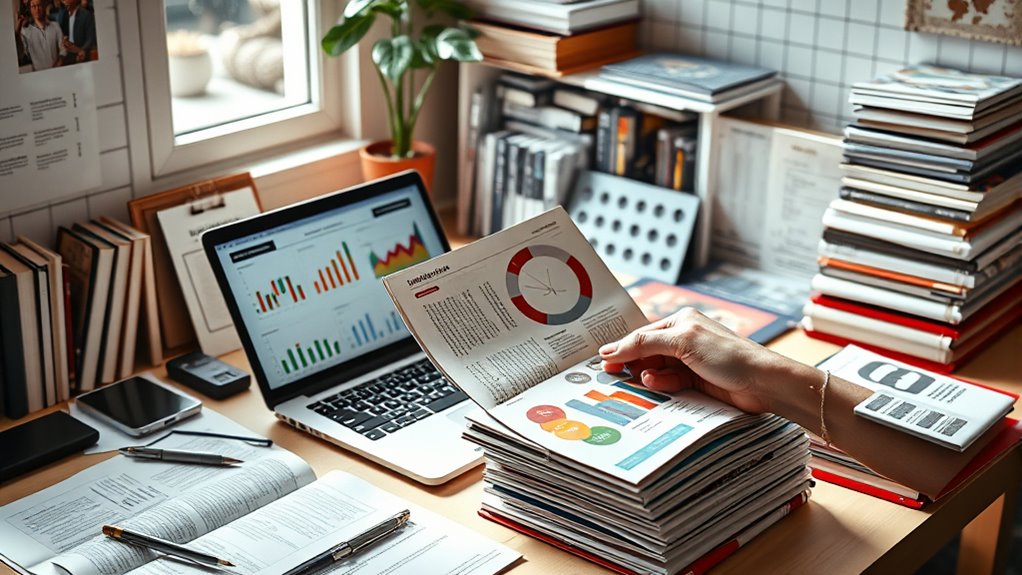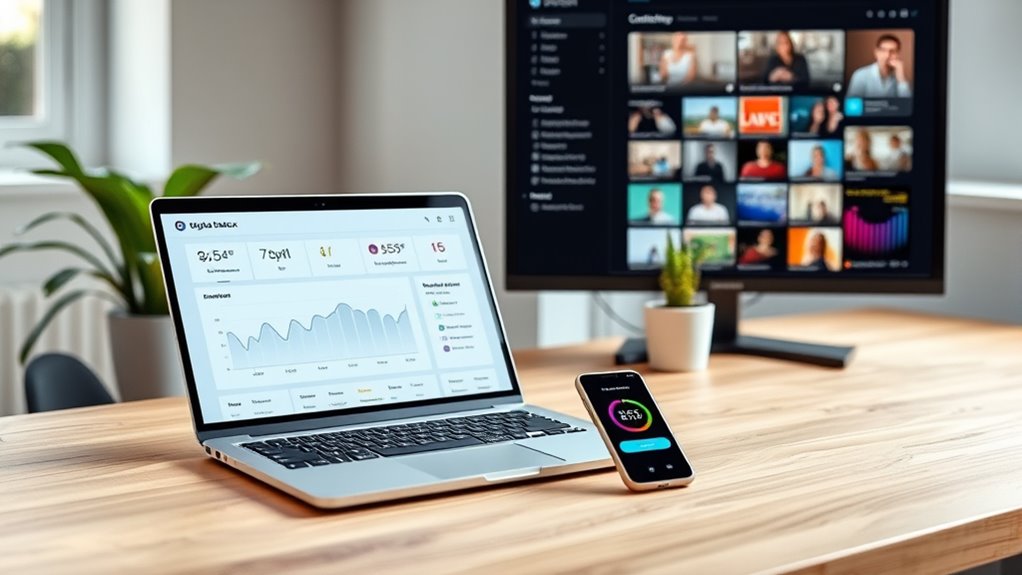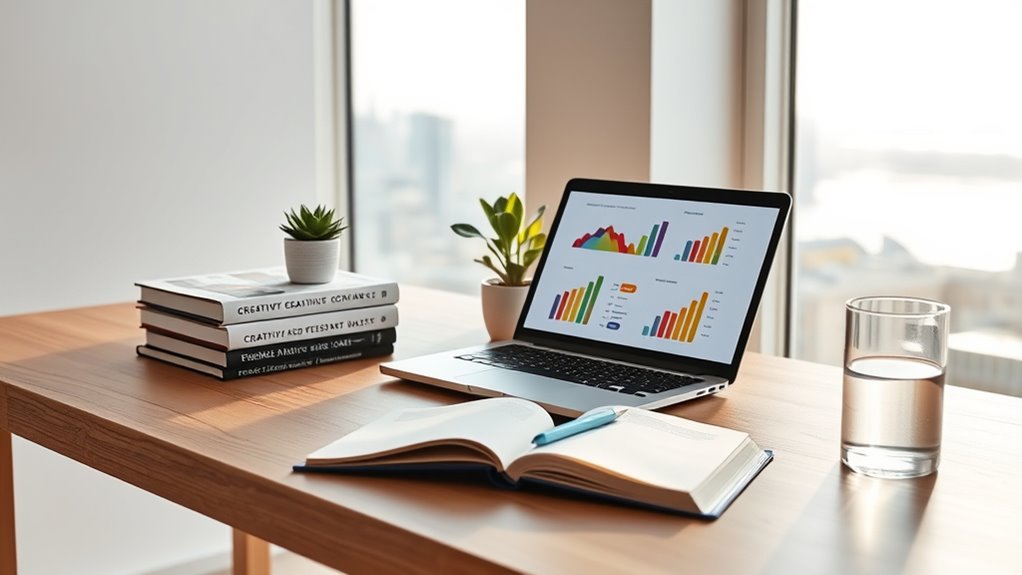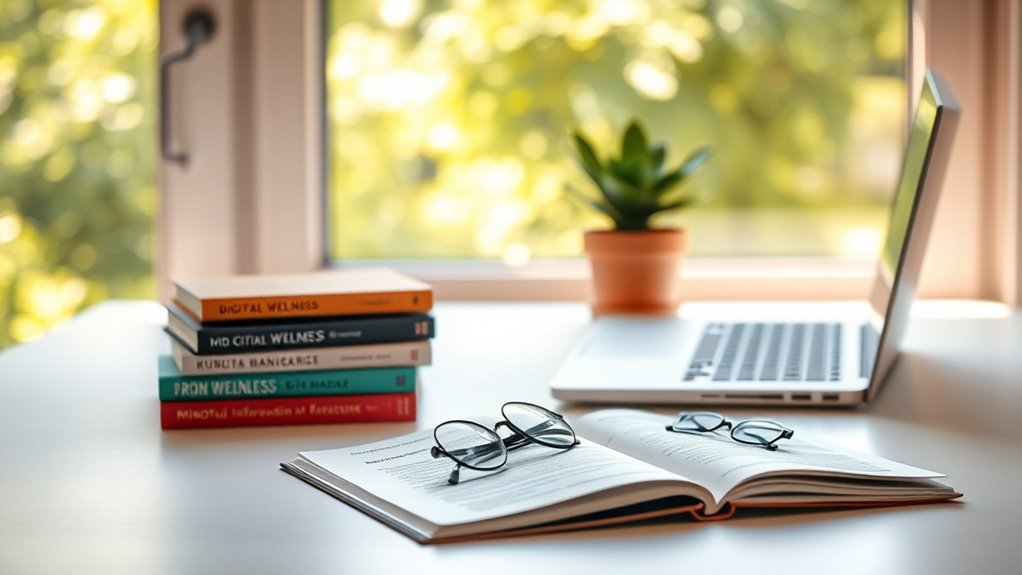To improve your outputs, you should curate your information diet intentionally. Focus on trusted sources, limit passive scrolling, and set boundaries for social media use. Practice mindfulness by pausing before engaging with content and reflect on how information affects your mental clarity. Avoid overload by regularly disconnecting and balancing consumption with creative and reflective activities. Keep refining your habits to foster better decision-making—if you keep exploring, you’ll discover even more effective ways to optimize your input.
Key Takeaways
- Curate trusted, high-quality sources to ensure accurate and reliable information intake for better decision-making.
- Set digital boundaries and scheduled content checks to prevent overload and maintain focus.
- Practice mindfulness by evaluating emotional impact and purpose behind consumed content.
- Limit passive scrolling and social media use to reduce mental clutter and enhance clarity.
- Regularly review and adapt your information plan to align with evolving goals and interests.
Understanding the Concept of an Information Diet

An information diet refers to the deliberate choice of the types and amounts of information you consume daily. To succeed, you need media literacy and digital literacy skills. Media literacy helps you evaluate sources, distinguish facts from opinions, and recognize bias. Digital literacy enables you to navigate online platforms efficiently and understand how algorithms influence what you see. By curating your information intake, you avoid overload and focus on quality content that benefits your understanding and decision-making. This conscious approach fosters better critical thinking and prevents misinformation from spreading into your mindset. Remember, an effective information diet isn’t just about cutting back; it’s about intentionally selecting meaningful, accurate, and relevant information to support your growth and well-being. Additionally, understanding cookie policies can help you manage your online privacy and avoid unnecessary data sharing.
The Impact of Digital Overload on Mental Clarity

When you constantly juggle multiple digital channels, your brain struggles to process information efficiently, leading to mental clutter. This overload makes it harder to focus, reason clearly, and retain important details. The constant influx of notifications, emails, and social media updates fragments your attention and heightens stress. To regain mental clarity, consider a digital detox—step away from screens for a set period. Taking regular breaks helps your mind reset, reducing overwhelm and sharpening your focus. Over time, limiting digital inputs allows your brain to process essential information more effectively. By curating your digital environment, you create space for clearer thinking and better decision-making. Incorporating mindfulness practices into your routine can further enhance your ability to stay present and focused. Essentially, reducing digital overload restores mental clarity, making you more productive and less anxious.
Identifying High-Quality Versus Low-Quality Content

When evaluating content, you need to consider its credibility and authority to make sure you’re getting accurate information. Check if the source is transparent about its origins and intentions, which helps you judge its trustworthiness. By paying attention to these factors, you can easily distinguish high-quality content from misleading or unreliable material. Incorporating analytical thinking into your assessment allows for a more thorough evaluation of the content’s validity and reliability.
Credibility and Authority
How can you tell if a piece of content is trustworthy or just empty information? Focus on source credibility and authority building. High-quality content comes from sources with expertise, proven track records, and reputable backgrounds. Look for signs like citations, author credentials, and clear references. Low-quality content often lacks these, relying instead on sensational claims or vague statements. To assess credibility:
- Check the author’s credentials and affiliations
- Look for citations and references
- Evaluate the website’s reputation and domain
- Notice if the content is recent and regularly updated
- Observe whether the language is balanced and free of sensationalism
Source Transparency
One of the quickest ways to gauge content quality is by examining its transparency about sources. Source transparency reveals whether a publisher openly shares where their information comes from, making it easier to assess credibility. High-quality content often includes clear citations and references, demonstrating a commitment to accuracy. Low-quality sources may lack transparency or rely on anonymous or questionable origins. To identify trustworthy information, practice fact checking by verifying claims through reputable, transparent sources. This process helps you distinguish between well-supported facts and misleading or false content. Prioritizing source transparency ensures you’re consuming reliable information, which in turn leads to better outputs in your understanding and decision-making. Remember, transparency isn’t just about honesty — it’s about empowering you to make informed judgments. Additionally, source credibility can be assessed by evaluating the reputation of the publishing entity and the expertise of the authors involved.
Strategies for Curating Your Daily Information Intake

To effectively manage your daily information intake, start by choosing reliable sources you trust. Limiting your time on social media helps prevent overload and distraction. Focus on consuming high-quality content that truly informs and inspires you. Being aware of manipulative behaviors commonly employed by narcissists can help you discern credible information from misleading or harmful content.
Select Reliable Sources
Ever wonder how to guarantee the information you consume is accurate and trustworthy? The key is selecting reliable sources. Focus on source verification—double-check facts and cross-reference data. Look for outlets with transparent authorship and clear editorial standards. Detect bias by comparing different perspectives to avoid a skewed view. Prioritize reputable institutions, academic publications, and well-known journalism outlets. Be cautious of sensational headlines or sources with a clear political agenda. Use fact-checking tools to verify claims quickly. Remember, not all sources are created equal, so develop a critical eye to discern credibility. A disciplined approach to source selection ensures you build a trustworthy information diet that supports informed decisions and meaningful conversations. Additionally, understanding the contrast ratio of your media sources can help you assess visual clarity and image quality, which is especially important when evaluating visual content.
Limit Social Media Time
Choosing reliable sources helps you build an accurate understanding of the world, but it’s equally important to manage how much time you spend on social media. Setting digital boundaries prevents social media from overwhelming your day and distorting your perspective. Consider implementing a social media detox by designating specific times when you disconnect completely, helping reset your habits. Use app timers or alerts to limit daily usage and avoid mindless scrolling. Creating intentional boundaries allows you to stay informed without sacrificing focus or mental clarity. Remember, reducing screen time isn’t about deprivation; it’s about reclaiming control over your input. By curating your social media habits, you ensure your information intake supports your well-being and productivity. Additionally, being mindful of the content quality you consume ensures that your digital interactions are both enriching and aligned with your goals.
Prioritize Quality Content
Prioritizing quality content means being intentional about the sources and types of information you consume each day. Focus on establishing a clear content hierarchy, where valuable and trustworthy sources take precedence over superficial ones. Pay attention to engagement metrics—likes, shares, and comments—to gauge what truly resonates and adds value. Curate a mix of in-depth articles, expert opinions, and well-researched reports instead of mindless scrolling. Regularly evaluate your feeds to remove low-quality or distracting content. Remember, your input shapes your output; consuming high-quality material sharpens your thinking and helps you make better decisions. By consciously choosing what to ingest, you create a more enriching, focused information diet that supports your growth and productivity. Incorporating mental clarity strategies can further enhance your ability to discern and prioritize valuable content.
Tools and Apps to Manage and Limit Distractions

Have you ever felt overwhelmed by constant notifications and digital distractions? If so, notification management tools can help you regain control. Apps like Freedom, StayFocusd, or Forest allow you to block distracting sites and set app detox periods, reducing interruptions during focused work. These tools help you create designated times for checking email or social media, preventing impulse scrolling. By limiting interruptions, you can improve concentration and productivity. Many apps also offer analytics, showing you how much time you spend on various platforms, so you can make informed decisions about your digital habits. Using these tools actively supports your goal of curating a healthier information diet. Incorporating notification management into your routine makes it easier to stay focused and avoid unnecessary digital noise.
The Role of Mindfulness in Consuming Information

Being mindful about the content you choose helps prevent information overload and keeps your focus sharp. When you intentionally select what to consume, you avoid wasting energy on irrelevant or overwhelming data. Practicing awareness in your information habits empowers you to stay balanced and intentional. Incorporating tools like content curation can further enhance your ability to filter and prioritize valuable information.
Mindful Content Selection
In today’s fast-paced digital world, practicing mindfulness while selecting content can substantially improve the quality of what you consume. When you’re mindful, you reduce news fatigue and avoid wasting time on irrelevant or overwhelming information. Focus on intentional content curation that aligns with your goals and values. This helps you stay present and avoid mindless scrolling.
Consider these tips:
- Pause before clicking to ask if it adds value
- Limit your sources to trusted outlets
- Set specific times for checking news
- Ignore sensational headlines
- Reflect on how content makes you feel
Avoiding Information Overload
Practicing mindfulness is essential for avoiding information overload, as it helps you stay aware of how much content you’re consuming and whether it truly serves your needs. Mindful reading encourages you to pause and evaluate whether each piece of information adds value or simply drains your mental resources. Incorporate regular digital detox periods to disconnect from screens and reduce the constant influx of data. Setting intentional limits on your media intake prevents overwhelm and keeps your focus sharp. Being mindful about your consumption habits allows you to prioritize quality over quantity, ensuring your inputs remain manageable and meaningful. By cultivating this awareness, you regain control over your digital environment, fostering clarity and preventing burnout from excessive information.
Developing a Personalized Information Consumption Plan

Creating a personalized information consumption plan starts with understanding your unique needs and goals. By tailoring your intake, you guarantee your consumption habits serve your growth and well-being. Focus on establishing a clear purpose for your information diet—what knowledge or skills you want to gain. Incorporate personalized curation by selecting sources that genuinely interest you and align with your objectives. Regularly evaluate your habits to identify what works and what doesn’t. Keep your plan flexible to adapt as your interests evolve. Remember, intentionality is key to avoiding overload and staying productive.
Here are some tips:
- Identify your core interests and goals
- Choose trusted, high-quality sources
- Limit time spent on passive scrolling
- Schedule regular review of your consumption habits
- Prioritize meaningful, actionable information
Balancing Consumption With Creative and Reflective Practices

While consuming information is essential for learning and staying informed, balancing it with creative and reflective practices enriches your understanding and prevents burnout. Engaging in creative reflection allows you to process what you’ve absorbed, fostering deeper insights and personal growth. Incorporate activities like journaling, brainstorming, or artistic expression to give your mind space for synthesis. These practices boost mental well being by reducing overstimulation and stress. When you deliberately step back from passive consumption, you create room for insight and innovation. This balance keeps your mind active and healthy, ensuring you don’t just gather information but also internalize and apply it meaningfully. Ultimately, blending consumption with creative reflection enhances your overall resilience and keeps your curiosity vibrant.
Recognizing the Signs of Information Fatigue

After actively engaging in creative reflection to process information, it’s important to stay alert for signs that you’re experiencing information fatigue. You might notice mental clutter piling up, making it harder to focus or think clearly. Feelings of overwhelm, irritability, or a sense of being mentally drained are common indicators. If you find yourself craving a digital detox or instinctively scrolling less, these are signs your mind needs a break. You could also experience difficulty retaining new information or feel disconnected from your surroundings. Recognizing these signs early helps prevent burnout and encourages you to reset your information intake. Pay attention to how your body and mind respond—your awareness is key to curating a healthier information diet.
Long-Term Benefits of Maintaining a Healthy Information Diet

Maintaining a healthy information diet offers lasting benefits that substantially enhance your overall well-being. Over time, it boosts your mental agility, helping you process information quickly and adapt to new challenges with ease. By consistently choosing quality inputs, you strengthen your cognitive resilience, making it easier to bounce back from mental fatigue or misinformation. This proactive approach reduces stress and sharpens your decision-making skills, fostering a clearer, more focused mindset. Long-term, a balanced information diet cultivates better concentration, improves memory, and supports emotional stability. As you build these habits, you’ll find it easier to filter out distractions and stay engaged with meaningful content. Ultimately, your sustained effort creates a healthier mental environment, empowering you to navigate life’s complexities with confidence and clarity.
Frequently Asked Questions
How Often Should I Review and Adjust My Information Diet?
You should review and adjust your information diet regularly to stay informed and avoid overwhelm. Conduct a personal audit every few weeks to assess what sources add value and which ones drain your energy. This helps you identify when a content refresh is needed. By staying proactive, you ensure your inputs align with your goals, keeping your information intake healthy, relevant, and productive.
What Are Common Signs of an Unhealthy Information Consumption Habit?
Imagine your brain’s a sponge drowning in a sea of media overload. If you constantly feel overwhelmed, distracted, or find yourself believing misinformation signs without question, you’ve got an unhealthy info habit. When your screen time skyrockets, opinions become muddled, or you struggle to focus, it’s a clear sign you’re swimming in too much content. Time to drain the excess and curate smarter inputs for a healthier mental diet.
Can an Information Diet Improve Productivity and Focus?
You can definitely boost your productivity and focus with an effective information diet. By doing a media detox and practicing digital minimalism, you reduce distractions and reclaim mental clarity. Limiting unnecessary inputs helps you concentrate on what truly matters, making your work more efficient. Regularly curating your digital environment allows you to stay engaged with valuable content, ultimately enhancing your overall performance and well-being.
How Do I Handle Conflicting Information Sources?
When handling conflicting information sources, you need to assess source credibility first. Check the author’s expertise, publication reputation, and evidence supporting their claims. Use bias detection techniques to identify any potential prejudices influencing the content. Cross-reference multiple reputable sources to verify facts, and remain open to adjusting your understanding as new, credible information emerges. This approach helps you navigate conflicts effectively and make well-informed decisions.
What Role Does Community or Social Input Play in My Information Diet?
Ever wonder how community engagement shapes your understanding? Your social input offers valuable perspectives and social validation, helping you filter and prioritize information. Engaging with others exposes you to diverse viewpoints, reducing echo chambers. It keeps you accountable and encourages critical thinking. By actively participating in your community, you refine your information diet, ensuring you receive balanced, credible inputs that empower you to make better decisions daily.
Conclusion
By curating your information diet, you’re planting seeds for a clearer mind and a more vibrant life. Think of it as tending a garden—removing weeds of distraction and nurturing nourishing content. When you choose what to consume wisely, your mental landscape blossoms with clarity and purpose. Embrace this mindful approach, and watch your inner world flourish like a well-tended sanctuary, radiant with focus and creativity.









